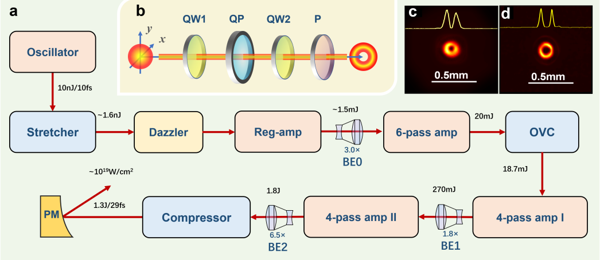Light with spiral phases, known as optical vortex, can carry orbital angular momentum (OAM), and is widely applied in microscale matter manipulation, microscopy, optical communication, intense laser interaction with materials, and so on. With the development of ultrashort and ultra-high power lasers, whose vortex versions have drawn significant attention. However, the existing high-energy-flux mode-converter, large size reflective phase-plate installed at the end of the laser, suffers from expensive cost, low spatial resolution, limited damage threshold, and is disturbed by topological charge dispersion which can degrade the vortex quality. Broadband mode-converter, e.g. Q-plate (a half waveplate with the optical axis rotating with azimuth), can realize broadband mode conversion but the energy flux is limited by its small manufacturable size.
Recently, a Joint Research Group from Shenzhen University and Shanghai Institute of Optics and Fine Mechanics (CAS) reported a vortex laser chirped-pulse amplification (CPA) system that delivers pulses with a peak power of 45 TW and low topological dispersion. This scheme uses a broadband mode-converter to generate high-quality vortex seed, then amplify it with a series of high-power amplifiers. The challenge lies in much higher requirements of amplification gain symmetry for the vortex beam than for the traditional Gaussian beam. The amplification system includes four-stage CPA amplifiers, which can output 100 TW Gaussian pulses, as shown in the following figure. A broadband Q-plate-based mode-converter is inserted after the second amplifier to generate 18-mJ vortex seed pulse. The mode-converter consists of a Q-plate, two quarter-waveplate, and a polarizer, where the polarization of pure vortex mode is perpendicular to the Gaussian mode noise which can be filtered through the final polarizer, with a mode-matching bandwidth as broad as hundreds of nanometers. The seed is then injected into the following two 4-pass amplifiers to scale up the pulse energy to 1.8 J. These two amplifiers are pumped by flat-top super-Gaussian beams that can reduce the requirement of gain symmetry. After a pulse compressor, the vortex pulse is compressed to 29 fs with an energy of 1.3 J for topological charges of both 1 and 2. The focused intensity of the output pulse by an F/4 off-axis parabolic mirror is estimated up to 2.7×1019 W/cm2.

Graphic description: Schematics of the vortex CPA experimental setup (a) and the optical vortex mode-converter (b). Far-field profiles of the amplified vortex laser for topological charges of l=1 (c) and l=2 (d).
The report verifies that vortex seed directly amplified in a CPA system is an efficient way for the generation of high-power, high-quality vortex laser, the potential of PW vortex laser. This provides a powerful tool for the study of strong-field light physics, such as vortex particle acceleration, strong magnetic field generation, intense terahertz vortex, vortex high-order harmonic generation, astrophysical simulation, and so on.
The research is published in High Power Laser Science and Engineering, Volume 10, Issue 5 (Chen Z, Zheng S, Lu X, Wang X, Cai Y, Wang C, Zheng M, Ai Y, Leng Y, Xu S, Fan D. Forty-five terawatt vortex ultrashort laser pulses from a chirped-pulse amplification system [J]. High Power Laser Science and Engineering, 2022, 10(5): 05000e32).
"Nextly, we aim to scale up the pulse power to PW level. Of course, the imperfect adaptive optics, the uniformity of laser amplification, the amplified spontaneous emission ( ASE) from the laser crystals, and other unknown problems, are all our enemies. Nevertheless, it is challenging but exhilarating." Said Yi Cai, a member of the Research Group.


